Physical Address
304 North Cardinal St.
Dorchester Center, MA 02124
The urinary system and the genital system are closely associated embryologically and begin to develop during the fourth week of gestation. Both develop from the intermediate mesoderm along the posterior wall of the abdominal cavity. A longitudinal elevation of the mesoderm, the urogenital ridge, forms on both sides of the abdominal aorta. Part of the urogenital ridge gives rise to the nephrogenic cord, which will form the urinary system, and another part gives rise to the gonadal ridge, which will form the genital system.
The nephrogenic cord gives rise to the mesonephros, which consists of glomeruli and mesonephric tubules. The mesonephric tubules open into the mesonephric duct, which soon opens into the cloaca. The mesonephros degenerates toward the end of the first trimester, although their tubules persist in males and participate in the formation of the genital system. During the fifth week of gestation, the metanephros begins to develop. The definitive kidneys develop from the ureteric bud (metanephric diverticulum), an outgrowth of the mesonephric duct, and the metanephric blastema, which is derived from the nephrogenic cord.
The ureteric bud is responsible for the development of the collecting system (ureter, renal pelvis, and calyces). The stalk of the ureteric bud forms the ureter. The ureteric bud grows into the metanephric blastema, where branching leads to the formation of the renal pelvis, major and minor calyces, and the collecting tubules ( Figs. 110.1 and 110.2 ). Nephrons form in the metanephric blastema as the result of induction by the collecting tubules. The embryonic kidneys initially lie in the pelvis. As the abdomen grows, the kidneys “ascend” and rotate 90 degrees. By the ninth week of gestation, the kidneys come in contact with the adrenal glands as they attain their final position. The fetal kidney has a lobulated external contour that will disappear as the nephrons continue to grow. The full complement of glomeruli is present by 36 weeks' gestation.
Congenital anomalies of the kidney and urinary tract are common. Early degeneration of a ureteric bud or involution of the metanephros leads to regression of the metanephric blastema and renal agenesis. Bifurcation of the ureteric bud results in urinary tract duplication. When the location of the origin of the ureteric bud is abnormal or if the origin itself is maldeveloped, the potential for vesicoureteral reflux (VUR) or ureteral ectopia exists ( Fig. 110.3 ).
The bladder arises from the most superior portion of the urogenital sinus. It is initially continuous with the allantois. With constriction of the allantois, the lumen is obliterated, and a fibrous cord, the urachus, remains. The urachus connects the apex of the bladder with the umbilicus. Persistence of the allantoic lumen may result in urachal fistulas, sinuses, or cysts. The ureterovesical junction (UVJ) develops as the distal parts of the mesonephric duct are incorporated into the enlarging bladder. As the mesonephric ducts are absorbed, the ureters come to open separately into the urinary bladder with the orifice moving superolaterally and the distal ureteral segments entering obliquely through the base of the bladder. The middle portion of the urogenital sinus develops into the prostatic urethra in males and the entire urethra in females. The distal portion of the male urethra is derived from a cord of ectoderm that grows from the tip of the glans penis to meet the spongy portion of the urethra derived from the caudal (phallic) portion of the urogenital sinus. Development of the ureters and bladder is complete by the fourth gestational month.
The fetus begins to make urine by the ninth week of gestation, and the urine contributes the largest component of the amniotic fluid. Oligohydramnios is often a marker of renal or urinary tract abnormalities, and severe oligohydramnios may lead to pulmonary hypoplasia.
During the first few days after birth, the neonate has a low glomerular filtration rate (GFR) and low urine output. This is especially true of premature infants. The newborn kidney also has a limited ability to concentrate urine and decreased tubular reabsorption of sodium. GFR and urine output increase significantly over the first week of life. This immaturity of renal function is an important factor to keep in mind in the ordering and interpretation of renal imaging studies in the setting of antenatal hydronephrosis.
Multiple renal lobules fuse to form the kidney. Each lobule is composed of two distinct regions: (1) the outer cortex and (2) the inner medulla ( Fig. 110.4 ). The medulla is composed of 8 to 13 pyramids, which terminate in the renal papillae at the level of the calyces. Two or more pyramids may drain into the same papilla (confluent papilla), and two or more papillae may drain into a single calyx (compound calyx). Occasionally, when lobules fuse, the renal cortex remains and extends centrally between the pyramids, representing a column of Bertin ( e-Fig. 110.5 ). A column of Bertin often occurs at the interpolar region or between the two moieties of a duplex kidney. Additionally, the junction of these lobules may persist and be seen as a scalloping or lobation of the cortical border ( Fig. 110.6 ). The junctional parenchymal defect is similarly derived from a variation in the fusion of the fetal lobules. It appears as a thick, triangular, echogenic notch in the anterosuperior or posteroinferior aspect of the kidney (more often on the right) and mimics a cortical scar. The junctional parenchymal defect may be connected to the renal hilum by an echogenic line called the interrenuncular septum ( Fig. 110.7 ). The left kidney is apt to be more triangular, with a distinct bulge along its lateral aspect, the dromedary hump ( Fig. 110.8 ).
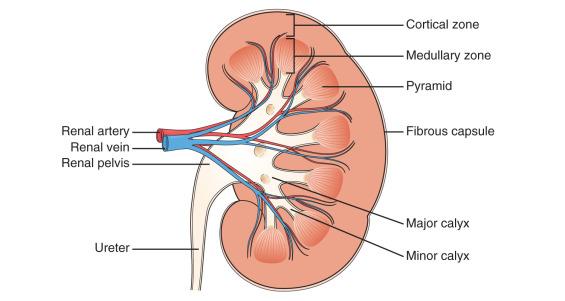
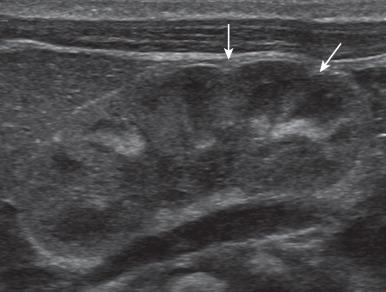
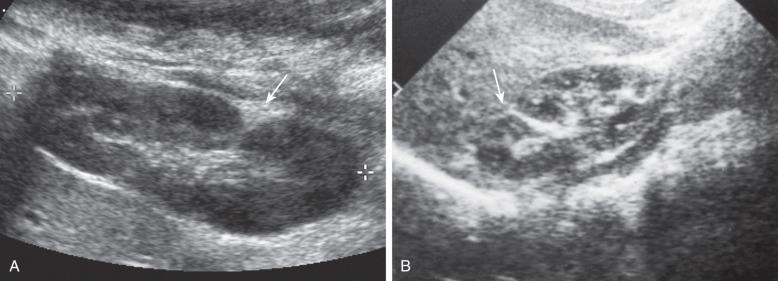
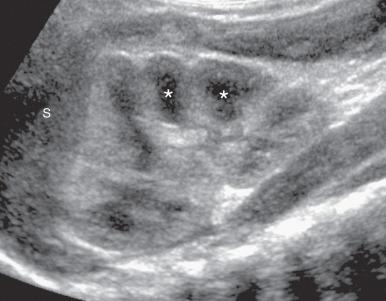
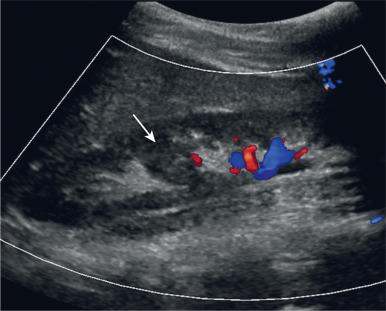
In newborns and infants, the kidneys have a larger medullary and smaller cortical volume than in later life. On ultrasonography, the neonatal renal cortex is moderately hyperechoic, close to the echogenicity of adjacent liver and spleen and can be greater than that of the liver in newborns and premature infants (see Fig. 110.8 ). The pyramids are relatively hypoechoic, maintaining corticomedullary differentiation. Between ages 6 months and 2 years, the echogenicity of the medulla and cortex resembles that of adult kidneys.
The kidney is usually supplied by a single artery arising from the abdominal aorta. After the renal artery enters the renal hilum, posterior and slightly superior to the renal vein, it divides into anterior and posterior branches, which, in turn, generally divide into superior and inferior branches ( e-Fig. 110.9 ). About 20% to 30% of kidneys have a second or accessory renal artery arising from the aorta. The left renal vein is longer than the right, courses anterior to the aorta, and receives the ipsilateral suprarenal and gonadal veins before entering the inferior vena cava. Variations exist at all levels.
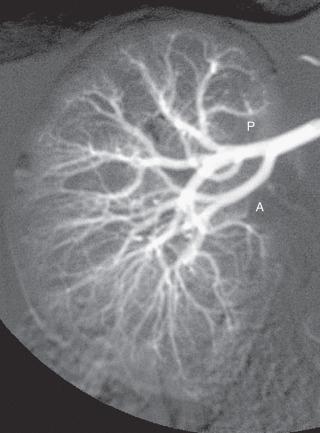
Renal length is the most commonly measured morphologic parameter and has been correlated to age, body height, and body weight. Standards for renal length have been developed for ultrasonography ( e-Fig. 110.10 ). The left kidney may be slightly longer than the right. Kidneys with complete or partial collecting system duplication are often longer than normal kidneys. The width of the kidney is approximately 50% of its length and is relatively thicker in neonates than older children. Cortical thickness of the upper renal pole is normally slightly thicker than the lower pole. Extra cortical tissue may be noted about the renal hilum and may impinge on the renal pelvis (suprahilar/infrahilar bulge, or hilar lips).
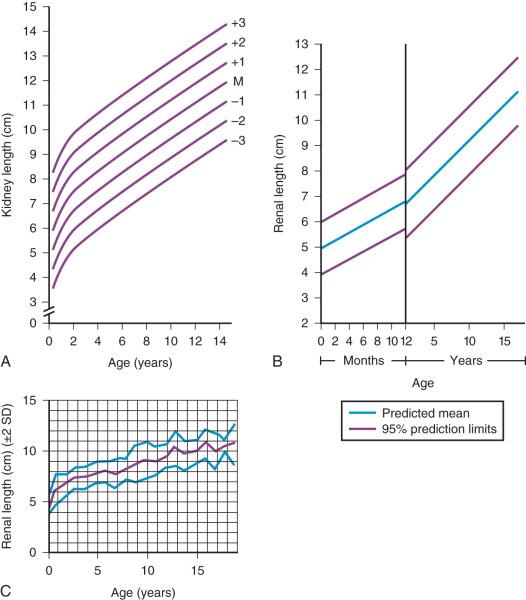
The renal pelvis varies in size and shape and may lie entirely within (intrarenal) or partly beyond (extrarenal) the renal sinus. In most kidneys, the pelvis branches into two major infundibula (or major calyces). The inferior infundibulum is commonly broad and short and is connected with a larger number of minor calyces compared with the upper infundibulum. Each kidney has about 8 to 13 minor calyces. These have a cup-shaped appearance that results from the protrusion of the renal papilla into the calyx. Most calyces are directed laterally and either slightly anteriorly or posteriorly within the kidney.
The ureter is a tubular structure that courses through the retroperitoneum from the kidney to the bladder and has three major components: (1) the ureteropelvic junction (UPJ) and proximal ureter, (2) the midureter, and (3) the distal ureter and UVJ (including the transmural ureter and the ureteral orifice). The proximal ureter starts at the UPJ with a smooth tapering from the renal pelvis. The ureter lies adjacent to the psoas muscle and is crossed by the gonadal vessels before passing over the iliac vessels. The lower ureter lies along the lateral pelvic wall, coursing behind the bladder. The ureter enters the bladder wall at an oblique angle and opens into the bladder. Its course through the bladder wall may be seen (called the plica ureterica at cystoscopy) and constitutes the lateral border of the bladder trigone. Three muscular layers constitute the ureteral wall, with a thick outer adventitial layer containing vessels and lymphatics.
The vascular supply of the ureter is primarily from the inferior vesical artery inferiorly, and the gonadal artery (e.g., testicular artery) and renal artery superiorly. Nerves supplying the ureter follow the arteries. Rhythmic peristaltic ureteral contractions transport urine from the renal pelvis into the urinary bladder two to seven times per minute.
The anatomic relationship of the distal ureter to the bladder wall at the UVJ is important in preventing VUR. Normally, the distal ureter courses through the bladder musculature at an oblique angle and then continues inferomedially and submucosally to its ostia in the lateral corner of the trigone ( Fig. 110.11 ). The UVJ acts as a passive flap valve. Continence is ensured by apposition of the roof and floor of the submucosal tunnel when intravesical pressure increases and is enhanced by contraction of the intrinsic local musculature.
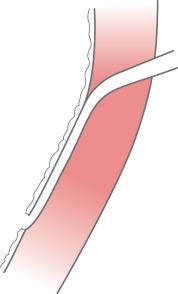
In the neonate and young child, the dome and body of the bladder are located primarily in the abdomen while the base is intrapelvic. Bowel impressions are common and may impress on the intraabdominal bladder when it is distended. This normal appearance should not be confused with a pelvic mass. A urachal remnant may be seen at the bladder dome, best seen on ultrasound and computed tomography (CT). Normal bladder capacity can be predicted on the basis of weight in infancy and by age for the older child. For infants under 1 year of age, bladder capacity in milliliters is predicted by multiplying the weight in kilograms by 7. The predicted bladder capacity in milliliters of children more than 1 year old is the age in years plus 2 multiplied by 30. Ultrasonography best demonstrates normal bladder wall thickness, which should be no more than 3 mm when distended and 6 mm when collapsed.
The female urethra is equivalent to the posterior urethra of the male. Anatomic features of the female urethra include the internal sphincter at the bladder neck, intermuscular incisura, membranous urethra at the level of the urogenital diaphragm or external urethral sphincter, and the fossa navicularis, although only the impressions of the sphincters are usually seen at imaging ( e-Fig. 110.12 ).
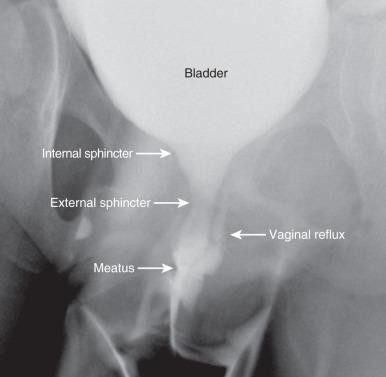
The components of the normal male urethra include the prostatic, membranous, bulbous, and penile urethra. Normal anatomic features of the male prostatic urethra include the internal sphincter, the intermuscular incisura, and the verumontanum. The verumontanum is a focal elevation in the posterior wall of the prostatic urethra, where the paired ejaculatory ducts enter, seen as a small ovoid filling defect in the posterior portion of the prostatic urethra. The plicae colliculae are normal folds that extend from the distal verumontanum and may produce circumferential impressions on urethral images.
The membranous urethra runs through the urogenital diaphragm or the external urethral sphincter and becomes the anterior urethra, consisting of the bulbous and penile segments, and the fossa navicularis ( e-Fig. 110.13 ). The muscles related to bladder continence and micturition are the detrusor muscle of the bladder, the musculature of the bladder neck and proximal urethra at the internal urethral sphincter, and the external urethral sphincter. The external sphincter is composed of striated voluntary muscles of the pelvic floor.
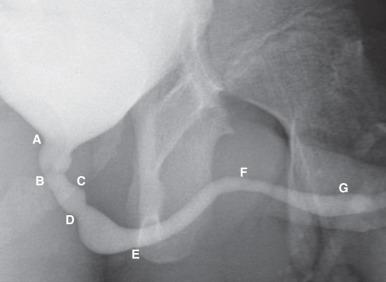
True renal agenesis is thought to be caused by failure of the ureteric bud to contact the ipsilateral metanephric blastema. Unilateral renal agenesis is present in about 1 : 1000 live births. Children with true unilateral renal agenesis lack the ipsilateral ureter and hemitrigone of the urinary bladder. Those children with an absent kidney but a normally developed bladder and a distal ureter of varying length probably represent the involution of a multicystic dysplastic kidney. Associated anomalies include VACTERL (vertebral defects, anorectal malformation, cardiac defects, tracheo-esophageal fistula, renal anomalies, and limb abnormalities) association ( e-Fig. 110.14 ), unicornuate uterus ( e-Fig. 110.14 ), uterus didelphys (obstructed hemivagina with ipsilateral renal agenesis, or OHVIRA), and Mayer-Rokitansky-Küster-Hauser syndrome in girls, and seminal vesicle cysts, absence of the vas deferens, and cystic dysplasia of the rete testis in boys ( Box 110.1 ).
Become a Clinical Tree membership for Full access and enjoy Unlimited articles
If you are a member. Log in here